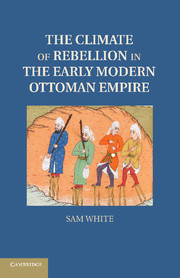Book contents
10 - City and Country
Published online by Cambridge University Press: 05 February 2012
Summary
The next major long-term shift in the human ecology of Ottoman lands was the mass movement of rural populations into towns and cities. As bandits and nomadic tribes invaded the countryside during the Little Ice Age crisis, the inhabitants were, to use the Ottoman phrasing, “scattered” (perakende). Some took to the hills and some migrated to more distant provinces or foreign lands in search of safety. Others still, probably millions, perished in the famine and violence. Yet over the long run the greatest number migrated to urban centers in search of food and safety. Even as so much settlement in the countryside lay abandoned, populations in the major cities – and above all in Istanbul – continued to rise, in a movement that continued well after the worst of the Little Ice Age crisis had passed.
- Type
- Chapter
- Information
- The Climate of Rebellion in the Early Modern Ottoman Empire , pp. 249 - 275Publisher: Cambridge University PressPrint publication year: 2011

